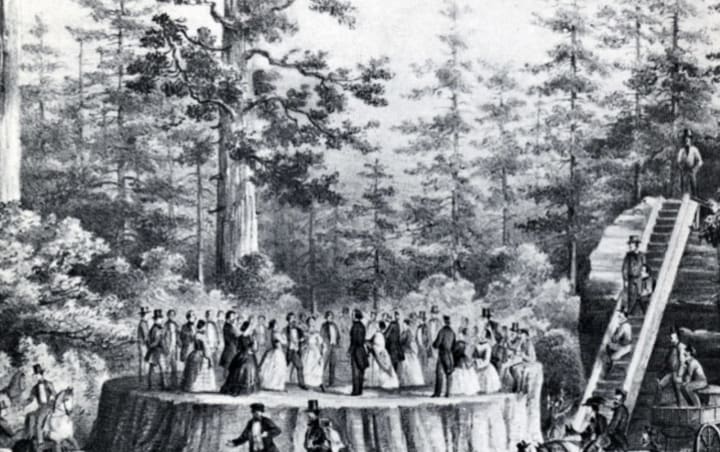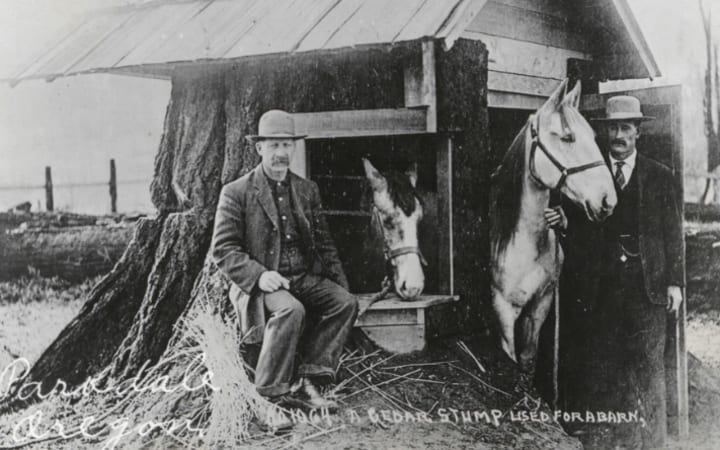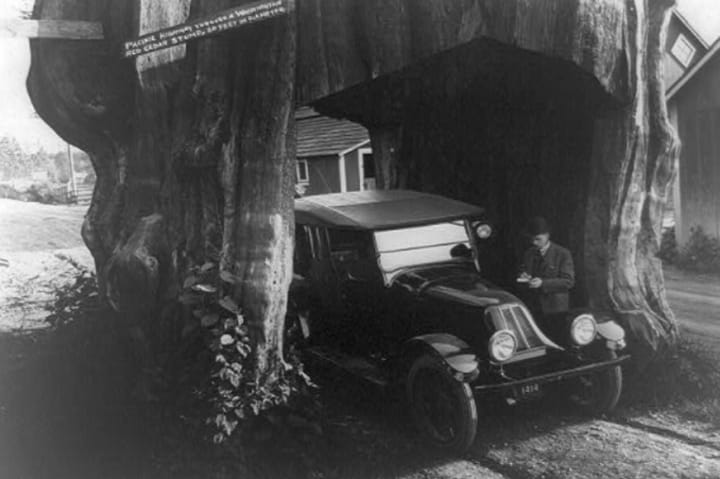Unique Stump Houses!
The surprising secret behind Stump Houses!

People in the 1800s or even in the Depression? 1930–1940! The sky is literally exploding without hope! It’s not just the cities, the whole darn country is in on the joke. And let’s be real, this cosmic comedy show has no punchline in sight!
Well, with the cost of housing on the rise all across America, many prospective home buyers might be wishing they had a time machine! You know, to go back to the days when you could buy a lot of land for less.
Now, spending the night or a weekend in a stump house might sound like an outdoor adventure or a neat camping trip. But let’s be real, it’s the kind of ‘camping’ where you might wake up with a stiff neck from sleeping on a hard surface... and a renewed appreciation for indoor plumbing!

In the 1800s, European settlers moved into Appalachia and the west. On the coast of America, housing was hard to find. The widespread logging of massive trees in Appalachia and on the west coast of America led to a severe housing shortage. Companies in Appalachia were cutting down chestnut trees up to 200 feet tall and 15 feet wide, while out west, Sequoias and Redwoods were also heavily logged. After the trees were harvested, large stumps were left behind.
Imagine a time when the hearts of every community beat around a towering stump. These weren’t just any old stumps—they were monuments to history, landmarks that told tales of the past. Many of these stumps became centerpieces in communities, serving as stages of the hopes and dreams of the people who gathered around them.
Politicians loved those stumps. They were natural platforms, perfect for delivering rousing speeches and making grand promises. With a confident roar echoing off the bark, each aspirant would lay out his vision for the future, swearing oaths he’d never break if only given the chance to lead. Some of those promises were kept, and some were broken, but that’s a story for another day. What matters is that those stumps gave birth to the term “stump speech"—testament to their enduring influence.
But the stumps weren’t just for politics. Oh no, they were the life of the party, too. Picture a lone fiddler perched atop a massive stump, his bow sawing through the air as he plays a hauntingly beautiful version of the Arkansas Traveler. The music drifts in the breeze, mingling with the laughter and voices of the crowd gathered below. That’s the magic of the stump—a simple piece of wood transformed into a conduit for joy and connection.

So the next time you pass a stump in the woods, or even just see one in a picture, take a moment to remember. Remember the stories it has witnessed, the dreams it has inspired, and the lives it has touched. The stump may seem like just a piece of wood, but it’s so much more. It’s a piece of history, a symbol of community, and a testament to the power of simple things.
Suddenly, you hear the faint but unmistakable sounds of laughter and music. You follow the sounds until you come upon a sight that will astound you—a massive tree stump, pulsing with life. Dozens of people are packed into the hollowed-out interior, dancing and celebrating. This is no ordinary tree stump—it’s a makeshift dance floor, a testament to human ingenuity and pioneering spirit.
But the marvels of these stump dwellings don’t end there. As you will see, these weren’t just temporary structures for community gatherings. Many people actually lived on these stumps, transforming them into cozy homes. How, you ask? Well, our intrepid pioneers were nothing if not resourceful.
A stump, left to stand proudly among the living. The wood closest to the ground is riddled with knots and twists, making it unsuitable for building. But the wood higher up? That’s prime real estate. So, with little more than a pickaxe and a dream, these pioneers set out to work.
They’d climb the tree, hacking away at the trunk until they reached a point where the wood was soft enough to carve. Then, using nothing more than basic hand tools, they’d painstakingly chip away at the inside of the stump, creating a hollow space large enough to live in. It was backbreaking work, but the rewards were immense.

With a sturdy roof overhead and a warm bed beneath you, that was the life of a stump dweller. A lifestyle born of necessity and a deep connection to nature. And while these homes may seem quaint or even primitive by today’s standards, they were a marvel of engineering and adaptability for their time.
A home so spacious, it feels like a palace. Rooms stretching up to 20 feet wide, bathed in sunlight streaming through gleaming windows. The crackle of a warm fireplace, the gentle creak of sturdy wooden doors. And best of all, a place you could call your own, free from the burden of rent or a mortgage.
This was the dream that came true when poverty was rampant. For many families in the 19th century, when owning a home seemed an impossible dream, stump houses offered a glimmer of hope. These remarkable structures were built from the trunks and roots of fallen trees, carved into livable spaces with an ingenuity that belied the scarcity of resources.
Some stump houses were single story, their simple elegance a testament to the strength of the wood and the skill of the builders. Others rose two or even three stories high, their windows peeking out like eyes from the forest floor. Inside, each room was a sanctuary, a private haven for each family member. No more sharing cramped quarters or shivering through cold winters—in a stump house, every person had a place to call their own.

But a stump house wasn’t just a home; it was a symbol of self-sufficiency and independence. For families who had long relied on the whims of landlords and the mercy of banks, owning a stump house was a source of immense pride. It was proof that with hard work and ingenuity, even the poorest among them could have a roof over their heads and a place to call home.
And the benefits of a stump house extended far beyond the walls of the home itself. These versatile structures served as shelters for livestock, providing a safe place for chickens and other animals to weather the storm. Their thick walls and sturdy roots offered protection from both the elements and potential predators.
Some pioneers even used stump houses as temporary homes while they cleared land and built more permanent dwellings. Imagine the sense of freedom and possibility that must have filled the air as a family moved into their new stump house, a place of their own in a rugged and beautiful wilderness.

The stories of stump houses are a testament to the resilience and creativity of the people who built them. They built these homes from the simple resources at hand, and in doing so, they created a legacy that has endured for generations. A stump house wasn’t just a home—it was a dream made real, a symbol of hope, and a reminder that with hard work and ingenuity, anything is possible!

The stump houses were more than just homes; they were symbols of a way of life. They stood as testaments to the ingenuity and resilience of a people who refused to let adversity defeat them. And their story has been passed down through the generations, immortalized in the 27 United States postcards that featured these iconic structures.
Many of the oldest stump houses were still inhabited well into the 20th century. Legends tell of the “old-timers” who lived in these simple abodes, their lives a link to a bygone era. These sturdy individuals embody the spirit of the people—a spirit of strength, resilience, and an unwavering commitment to their land and community.
The legacy of the stump houses extends far beyond their role as shelters. They serve as a powerful reminder of the unbroken spirit of the American experiment—a spirit of innovation, adaptability, and the indomitable will to overcome. The story of the stump houses is a chapter in the larger saga of the American project, a testament to the resilience of the human spirit in the face of adversity.

Thanks,
Chat?
https://vocal.media/authors/marie-e-ehlenbach
https://www.etsy.com/shop/momentstosip/?etsrc=sdt
I’m @[email protected] on #Mastodon! Come follow me at https://flipboard.social/@newstoriesforamagazine
About the Creator
marie e ehlenbach
I started writing when I found my imagination needed a place to be! Yes, I will write about anything that comes to mind! Living near the National Park in Washington, DC. I find it is the place to go to let your imagination take over!






Comments
There are no comments for this story
Be the first to respond and start the conversation.